MarrNet: 3D Shape Reconstruction via 2.5D Sketches: Difference between revisions
| (5 intermediate revisions by 3 users not shown) | |||
| Line 120: | Line 120: | ||
=== Method === | === Method === | ||
MarrNet is trained without the final fine-tuning stage, since 3D shapes are available. A baseline is created that directly predicts the 3D shape using the same 3D shape estimator architecture with no 2.5D sketch estimation. | MarrNet is trained following the training paradigm defined previously but without the final fine-tuning stage, since 3D shapes are available. A baseline is created that directly predicts the 3D shape using the same 3D shape estimator architecture with no 2.5D sketch estimation. Specifically, the 2.5D sketch estimator is trained using ground truth depth, normal and silhouette images and a L2 reconstruction loss. The 3D shape estimation module takes in the masked ground truth depth and normal images as input, and predicts 3D voxels of size 128×128×128 with a binary cross entropy loss. | ||
=== Results === | === Results === | ||
| Line 131: | Line 131: | ||
=== Method === | === Method === | ||
Also followed the paradigm described and train each module separately on the ShapeNet dataset. Then fine-tuned on the PASCAL 3D+ dataset. Three variants of the model are tested. Unlike previous works this model requires no silhouettes as input during fine-tuning; it instead estimates silhouette jointly. As an ablation study, the author compare three variants of our model: The first is trained using ShapeNet data only without fine-tuning. The second is fine-tuned without fixing the decoder. The third is fine-tuned with a fixed decoder. | |||
=== Results === | === Results === | ||
| Line 174: | Line 174: | ||
Also there is ambiguity in terms of how the aforementioned self-supervision can work as the authors claim that the model can be fine-tuned using a single image itself. If the parameters are constrained to a single image, then it means it will not generalize well. It is not clearly explained as to what can be fine-tuned. | Also there is ambiguity in terms of how the aforementioned self-supervision can work as the authors claim that the model can be fine-tuned using a single image itself. If the parameters are constrained to a single image, then it means it will not generalize well. It is not clearly explained as to what can be fine-tuned. | ||
The paper does not propose or implement a baseline model to which MarrNet should be compared. | |||
The model uses information from a single image. 3D shape estimation in biological agents incorporates information from multiple images or even video. A logical next step for improving this model would be to include images of the object from multiple angles. | |||
= Conclusion = | = Conclusion = | ||
We proposed MarrNet, a novel model that explicitly models 2.5D sketches for single image 3D | |||
shape reconstruction. The use of 2.5D sketches enhanced the model’s performance, and made it | |||
easily adaptive to images across domains or even categories. We also developed differentiable loss | |||
functions for the consistency between 3D shape and 2.5D sketches, so that MarrNet can be end-to-end | |||
fine-tuned on real images without annotations. Experiments demonstrated that our model performs | |||
well, and is preferred by human annotators over competitors. | |||
= Implementation = | = Implementation = | ||
Latest revision as of 22:42, 20 April 2018
Introduction
Humans are able to quickly recognize 3D shapes from images, even in spite of drastic differences in object texture, material, lighting, and background.

In this work, the authors propose a novel end-to-end trainable model that sequentially estimates 2.5D sketches and 3D object shape from images and also enforce re-projection consistency between the 3D shape and the estimated sketch. 2.5D is the construction of a 3D environment using 2D retina projection along with depth perception obtained from the image. The two step approach makes the network more robust to differences in object texture, material, lighting and background. Based on the idea from [Marr, 1982] that human 3D perception relies on recovering 2.5D sketches, which include depth maps (contains information related to the distance of surfaces from a viewpoint) and surface normal maps (technique for adding the illusion of depth details to surfaces using an image's RGB information), the authors design an end-to-end trainable pipeline which they call MarrNet. MarrNet first estimates depth, normal maps, and silhouette, followed by a 3D shape. MarrNet uses an encoder-decoder structure for the sub-components of the framework.
The authors claim several unique advantages to their method. Single image 3D reconstruction is a highly under-constrained problem, requiring strong prior knowledge of object shapes. As well, accurate 3D object annotations using real images are not common, and many previous approaches rely on purely synthetic data. However, most of these methods suffer from domain adaptation due to imperfect rendering.
Using 2.5D sketches can alleviate the challenges of domain transfer. It is straightforward to generate perfect object surface normals and depths using a graphics engine. Since 2.5D sketches contain only depth, surface normal, and silhouette information, the second step of recovering 3D shape can be trained purely from synthetic data. As well, the introduction of differentiable constraints between 2.5D sketches and 3D shape makes it possible to fine-tune the system, even without any annotations.
The framework is evaluated on both synthetic objects from ShapeNet, and real images from PASCAL 3D+, showing good qualitative and quantitative performance in 3D shape reconstruction.
Related Work
2.5D Sketch Recovery
Researchers have explored recovering 2.5D information from shading, texture, and colour images in the past. More recently, the development of depth sensors has led to the creation of large RGB-D datasets, and papers on estimating depth, surface normals, and other intrinsic images using deep networks. While this method employs 2.5D estimation, the final output is a full 3D shape of an object.
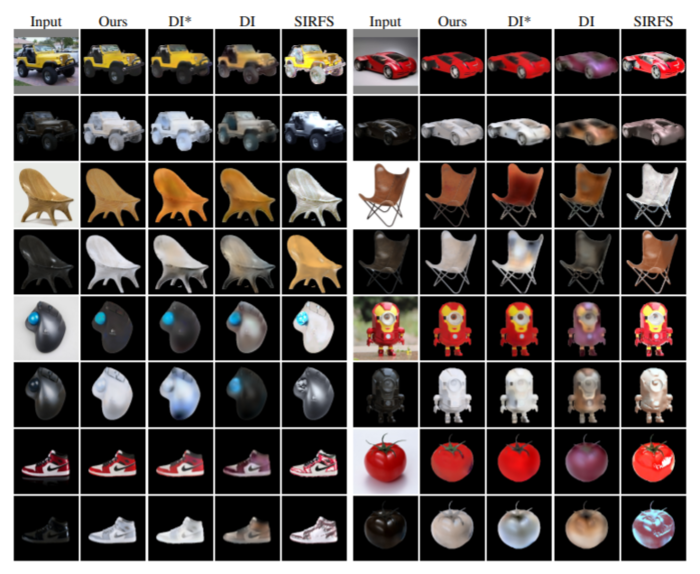
Notes: 2.5D
Two and a half dimensional (shortened to 2.5D, known alternatively as three-quarter perspective and pseudo-3D) is a term used to describe either 2D graphical projections and similar techniques used to cause images to simulate the appearance of being three-dimensional (3D) when in fact they are not, or gameplay in an otherwise three-dimensional video game that is restricted to a two-dimensional plane or has a virtual camera with fixed angle.
Single Image 3D Reconstruction
The development of large-scale shape repositories like ShapeNet has allowed for the development of models encoding shape priors for single image 3D reconstruction. These methods normally regress voxelized 3D shapes, relying on synthetic data or 2D masks for training. A voxel is an abbreviation for volume element, the three-dimensional version of a pixel. The formulation in the paper tackles domain adaptation better, since the network can be fine-tuned on images without any annotations.
2D-3D Consistency
Intuitively, the 3D shape can be constrained to be consistent with 2D observations. This idea has been explored for decades, and has been widely used in 3D shape completion with the use of depths and silhouettes. A few recent papers [5,6,7,8] discussed enforcing differentiable 2D-3D constraints between shape and silhouettes to enable joint training of deep networks for the task of 3D reconstruction. In this work, this idea is exploited to develop differentiable constraints for consistency between the 2.5D sketches and 3D shape.
Approach
The 3D structure is recovered from a single RGB view using three steps, shown in the figure below. The first step estimates 2.5D sketches, including depth, surface normal, and silhouette of the object. The second step estimates a 3D voxel representation of the object. The third step uses a reprojection consistency function to enforce the 2.5D sketch and 3D structure alignment.
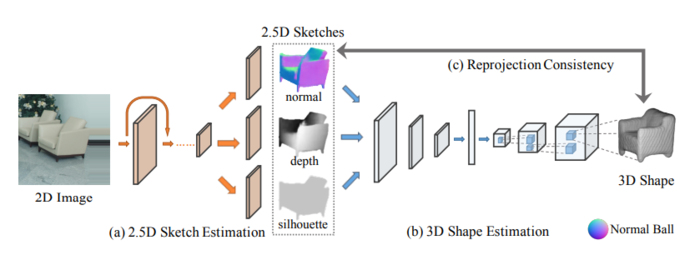
2.5D Sketch Estimation
The first step takes a 2D RGB image and predicts the 2.5 sketch with surface normal, depth, and silhouette of the object. The goal is to estimate intrinsic object properties from the image, while discarding non-essential information such as texture and lighting. An encoder-decoder architecture is used. The encoder is a A ResNet-18 network, which takes a 256 x 256 RGB image and produces 512 feature maps of size 8 x 8. The decoder is four sets of 5 x 5 fully convolutional and ReLU layers, followed by four sets of 1 x 1 convolutional and ReLU layers. The output is 256 x 256 resolution depth, surface normal, and silhouette images.
3D Shape Estimation
The second step estimates a voxelized 3D shape using the 2.5D sketches from the first step. The focus here is for the network to learn the shape prior that can explain the input well, and can be trained on synthetic data without suffering from the domain adaptation problem since it only takes in surface normal and depth images as input. The network architecture is inspired by the TL[10] network, and 3D-VAE-GAN, with an encoder-decoder structure. The normal and depth image, masked by the estimated silhouette, are passed into 5 sets of convolutional, ReLU, and pooling layers, followed by two fully connected layers, with a final output width of 200. The 200-dimensional vector is passed into a decoder of 5 fully convolutional and ReLU layers, outputting a 128 x 128 x 128 voxelized estimate of the input.
Re-projection Consistency
The third step consists of a depth re-projection loss and surface normal re-projection loss. Here, [math]\displaystyle{ v_{x, y, z} }[/math] represents the value at position [math]\displaystyle{ (x, y, z) }[/math] in a 3D voxel grid, with [math]\displaystyle{ v_{x, y, z} \in [0, 1] ∀ x, y, z }[/math]. [math]\displaystyle{ d_{x, y} }[/math] denotes the estimated depth at position [math]\displaystyle{ (x, y) }[/math], [math]\displaystyle{ n_{x, y} = (n_a, n_b, n_c) }[/math] denotes the estimated surface normal. Orthographic projection is used.

Depths
The voxel with depth [math]\displaystyle{ v_{x, y}, d_{x, y} }[/math] should be 1, while all voxels in front of it should be 0. This ensures the estimated 3D shape matches the estimated depth values. The projected depth loss and its gradient are defined as follows:
[math]\displaystyle{ L_{depth}(x, y, z)= \left\{ \begin{array}{ll} v^2_{x, y, z}, & z \lt d_{x, y} \\ (1 - v_{x, y, z})^2, & z = d_{x, y} \\ 0, & z \gt d_{x, y} \\ \end{array} \right. }[/math]
[math]\displaystyle{ \frac{∂L_{depth}(x, y, z)}{∂v_{x, y, z}} = \left\{ \begin{array}{ll} 2v{x, y, z}, & z \lt d_{x, y} \\ 2(v_{x, y, z} - 1), & z = d_{x, y} \\ 0, & z \gt d_{x, y} \\ \end{array} \right. }[/math]
When [math]\displaystyle{ d_{x, y} = \infty }[/math], all voxels in front of it should be 0 when there is no intersection between the line and its shape, referred as the silhouette criterion.
Surface Normals
Since vectors [math]\displaystyle{ n_{x} = (0, −n_{c}, n_{b}) }[/math] and [math]\displaystyle{ n_{y} = (−n_{c}, 0, n_{a}) }[/math] are orthogonal to the normal vector [math]\displaystyle{ n_{x, y} = (n_{a}, n_{b}, n_{c}) }[/math], they can be normalized to obtain [math]\displaystyle{ n’_{x} = (0, −1, n_{b}/n_{c}) }[/math] and [math]\displaystyle{ n’_{y} = (−1, 0, n_{a}/n_{c}) }[/math] on the estimated surface plane at [math]\displaystyle{ (x, y, z) }[/math]. The projected surface normal tried to guarantee voxels at [math]\displaystyle{ (x, y, z) ± n’_{x} }[/math] and [math]\displaystyle{ (x, y, z) ± n’_{y} }[/math] should be 1 to match the estimated normal. The constraints are only applied when the target voxels are inside the estimated silhouette.
The projected surface normal loss is defined as follows, with [math]\displaystyle{ z = d_{x, y} }[/math]:
[math]\displaystyle{ L_{normal}(x, y, z) = (1 - v_{x, y-1, z+\frac{n_b}{n_c}})^2 + (1 - v_{x, y+1, z-\frac{n_b}{n_c}})^2 + (1 - v_{x-1, y, z+\frac{n_a}{n_c}})^2 + (1 - v_{x+1, y, z-\frac{n_a}{n_c}})^2 }[/math]
Gradients along x are:
[math]\displaystyle{ \frac{dL_{normal}(x, y, z)}{dv_{x-1, y, z+\frac{n_a}{n_c}}} = 2(v_{x-1, y, z+\frac{n_a}{n_c}}-1) }[/math] and [math]\displaystyle{ \frac{dL_{normal}(x, y, z)}{dv_{x+1, y, z-\frac{n_a}{n_c}}} = 2(v_{x+1, y, z-\frac{n_a}{n_c}}-1) }[/math]
Gradients along y are:
[math]\displaystyle{ \frac{dL_{normal}(x, y, z)}{dv_{x, y-1, z+\frac{n_b}{n_c}}} = 2(v_{x, y-1, z+\frac{n_b}{n_c}}-1) }[/math] and [math]\displaystyle{ \frac{dL_{normal}(x, y, z)}{dv_{x, y+1, z-\frac{n_b}{n_c}}} = 2(v_{x, y+1, z-\frac{n_b}{n_c}}-1) }[/math]
Training
The 2.5D and 3D estimation components are first pre-trained separately on synthetic data from ShapeNet, and then fine-tuned on real images.
For pre-training, the 2.5D sketch estimator is trained on synthetic ShapeNet depth, surface normal, and silhouette ground truth, using an L2 loss. The 3D estimator is trained with ground truth voxels using a cross-entropy loss.
Reprojection consistency loss is used to fine-tune the 3D estimation using real images, using the predicted depth, normals, and silhouette. A straightforward implementation leads to shapes that explain the 2.5D sketches well, but lead to unrealistic 3D appearance due to overfitting.
Instead, the decoder of the 3D estimator is fixed, and only the encoder is fine-tuned. The model is fine-tuned separately on each image for 40 iterations, which takes up to 10 seconds on the GPU. Without fine-tuning, testing time takes around 100 milliseconds. SGD is used for optimization with batch size of 4, learning rate of 0.001, and momentum of 0.9.
Evaluation
Qualitative and quantitative results are provided using different variants of the framework. The framework is evaluated on both synthetic and real images on three datasets; ShapeNet, PASCAL 3D+, and IKEA. Intersection-over-Union (IoU) is the main measurement of comparison between the models. However the authors note that models which focus on the IoU metric fail to capture the details of the object they are trying to model, disregarding details to focus on the overall shape. To counter this drawback they poll people on which reconstruction is preferred. IoU is also computationally inefficient since it has to check over all possible scales.
ShapeNet
The data is based on synthesized images of ShapeNet chairs [Chang et al., 2015]. From the SUN database [Xiao et al., 2010], they combine the chars with random backgrounds and use a physics-based renderer by Jakob to render the corresponding RGB, depth, surface normal, and silhouette images. Synthesized images of 6,778 chairs from ShapeNet are rendered from 20 random viewpoints. The chairs are placed in front of random background from the SUN dataset, and the RGB, depth, normal, and silhouette images are rendered using the physics-based renderer Mitsuba for more realistic images.
Method
MarrNet is trained following the training paradigm defined previously but without the final fine-tuning stage, since 3D shapes are available. A baseline is created that directly predicts the 3D shape using the same 3D shape estimator architecture with no 2.5D sketch estimation. Specifically, the 2.5D sketch estimator is trained using ground truth depth, normal and silhouette images and a L2 reconstruction loss. The 3D shape estimation module takes in the masked ground truth depth and normal images as input, and predicts 3D voxels of size 128×128×128 with a binary cross entropy loss.
Results
The baseline output is compared to the full framework, and the figure below shows that MarrNet provides model outputs with more details and smoother surfaces than the baseline. The estimated normal and depth images are able to extract intrinsic information about object shape while leaving behind non-essential information such as textures from the original images. Quantitatively, the full model also achieves 0.57 integer over union score (which compares the overlap of the predicted model and ground truth), which is higher than the direct prediction baseline.
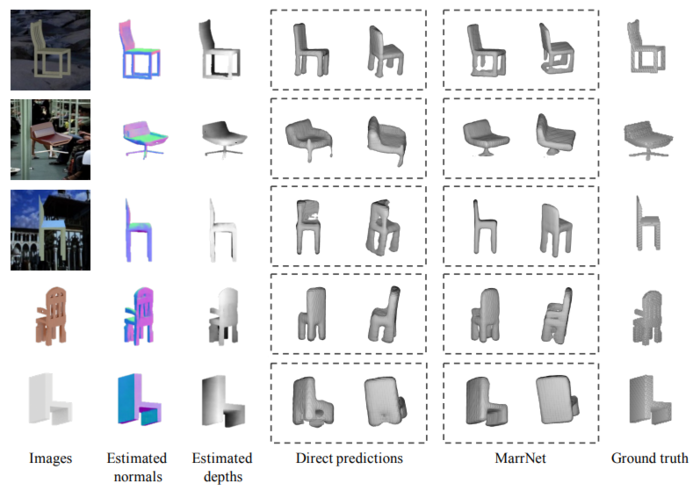
PASCAL 3D+
Rough 3D models are provided from real-life images.
Method
Also followed the paradigm described and train each module separately on the ShapeNet dataset. Then fine-tuned on the PASCAL 3D+ dataset. Three variants of the model are tested. Unlike previous works this model requires no silhouettes as input during fine-tuning; it instead estimates silhouette jointly. As an ablation study, the author compare three variants of our model: The first is trained using ShapeNet data only without fine-tuning. The second is fine-tuned without fixing the decoder. The third is fine-tuned with a fixed decoder.
Results
The figure below shows the results of the ablation study. The model trained only on synthetic data provides reasonable estimates. However, fine-tuning without fixing the decoder leads to impossible shapes from certain views. The third model keeps the shape prior, providing more details in the final shape.
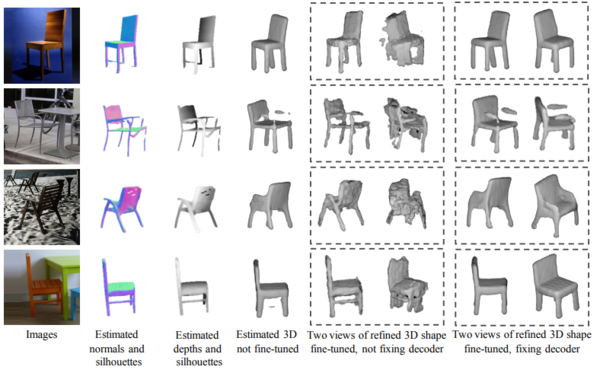
Additional comparisons are made with the state-of-the-art (DRC) on the provided ground truth shapes. MarrNet achieves 0.39 IoU, while DRC achieves 0.34. Since PASCAL 3D+ only has rough annotations, with only 10 CAD chair models for all images, computing IoU with these shapes is not very informative. Instead, human studies are conducted and MarrNet reconstructions are preferred 74% of the time over DRC, and 42% of the time to ground truth. This shows how MarrNet produces nice shapes and also highlights the fact that ground truth shapes are not very good.
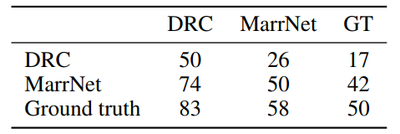
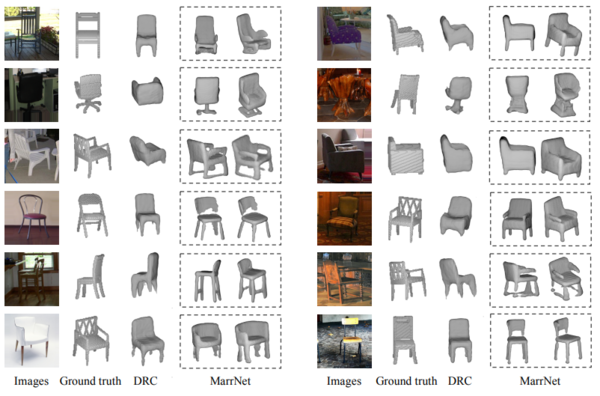
Several failure cases are shown in the figure below. Specifically, the framework does not seem to work well on thin structures.
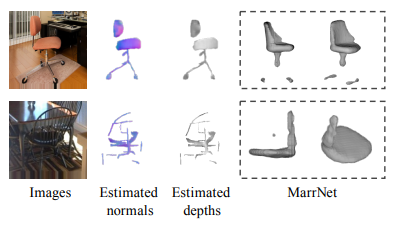
IKEA
This dataset contains images of IKEA furniture, with accurate 3D shape and pose annotations. Objects are often heavily occluded or truncated.
Results
Qualitative results are shown in the figure below. The model is shown to deal with mild occlusions in real life scenarios. Human studes show that MarrNet reconstructions are preferred 61% of the time to 3D-VAE-GAN.
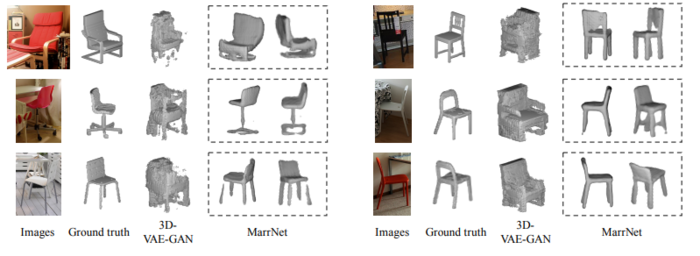
Other Data
MarrNet is also applied on cars and airplanes. Shown below, smaller details such as the horizontal stabilizer and rear-view mirrors are recovered.

MarrNet is also jointly trained on three object categories, and successfully recovers the shapes of different categories. Results are shown in the figure below.

Commentary
Qualitatively, the results look quite impressive. The 2.5D sketch estimation seems to distill the useful information for more realistic looking 3D shape estimation. The disentanglement of 2.5D and 3D estimation steps also allows for easier training and domain adaptation from synthetic data.
As the authors mention, the IoU metric is not very descriptive, and most of the comparisons in this paper are only qualitative, mainly being human preference studies. A better quantitative evaluation metric would greatly help in making an unbiased comparison between different results.
As seen in several of the results, the network does not deal well with objects that have thin structures, which is particularly noticeable with many of the chair arm rests. As well, looking more carefully at some results, it seems that fine-tuning only the 3D encoder does not seem to transfer well to unseen objects, since shape priors have already been learned by the decoder. Therefore, future work should address more "difficult" shapes and forms; it should be more difficult to generalize shapes that are more complex than furniture.
Also there is ambiguity in terms of how the aforementioned self-supervision can work as the authors claim that the model can be fine-tuned using a single image itself. If the parameters are constrained to a single image, then it means it will not generalize well. It is not clearly explained as to what can be fine-tuned.
The paper does not propose or implement a baseline model to which MarrNet should be compared.
The model uses information from a single image. 3D shape estimation in biological agents incorporates information from multiple images or even video. A logical next step for improving this model would be to include images of the object from multiple angles.
Conclusion
We proposed MarrNet, a novel model that explicitly models 2.5D sketches for single image 3D shape reconstruction. The use of 2.5D sketches enhanced the model’s performance, and made it easily adaptive to images across domains or even categories. We also developed differentiable loss functions for the consistency between 3D shape and 2.5D sketches, so that MarrNet can be end-to-end fine-tuned on real images without annotations. Experiments demonstrated that our model performs well, and is preferred by human annotators over competitors.
Implementation
The following repository provides the source code for the paper. The repository provides the source code as written by the authors: https://github.com/jiajunwu/marrnet
References
- Jiajun Wu, Yifan Wang, Tianfan Xue, Xingyuan Sun, William T. Freeman, Joshua B. Tenenbaum. MarrNet: 3D Shape Reconstruction via 2.5D Sketches, 2017
- David Marr. Vision: A computational investigation into the human representation and processing of visual information. W. H. Freeman and Company, 1982.
- Shubham Tulsiani, Tinghui Zhou, Alexei A Efros, and Jitendra Malik. Multi-view supervision for single-view reconstruction via differentiable ray consistency. In CVPR, 2017.
- JiajunWu, Chengkai Zhang, Tianfan Xue,William T Freeman, and Joshua B Tenenbaum. Learning a Proba- bilistic Latent Space of Object Shapes via 3D Generative-Adversarial Modeling. In NIPS, 2016b.
- Wu, J. (n.d.). Jiajunwu/marrnet. Retrieved March 25, 2018, from https://github.com/jiajunwu/marrnet
- Jiajun Wu, Tianfan Xue, Joseph J Lim, Yuandong Tian, Joshua B Tenenbaum, Antonio Torralba, and William T Freeman. Single image 3d interpreter network. In ECCV, 2016a.
- Xinchen Yan, Jimei Yang, Ersin Yumer, Yijie Guo, and Honglak Lee. Perspective transformer nets: Learning single-view 3d object reconstruction without 3d supervision. In NIPS, 2016.
- Danilo Jimenez Rezende, SM Ali Eslami, Shakir Mohamed, Peter Battaglia, Max Jaderberg, and Nicolas Heess. Unsupervised learning of 3d structure from images. In NIPS, 2016.
- Shubham Tulsiani, Tinghui Zhou, Alexei A Efros, and Jitendra Malik. Multi-view supervision for single-view reconstruction via differentiable ray consistency. In CVPR, 2017.
- Rohit Girdhar, David F. Fouhey, Mikel Rodriguez and Abhinav Gupta, Learning a Predictable and Generative Vector Representation for Objects, in ECCV 2016
- Angel X Chang, Thomas Funkhouser, Leonidas Guibas, Pat Hanrahan, Qixing Huang, Zimo Li, Silvio Savarese, Manolis Savva, Shuran Song, Hao Su, et al. Shapenet: An information-rich 3d model repository. arXiv:1512.03012, 2015.
- Jianxiong Xiao, James Hays, Krista A Ehinger, Aude Oliva, and Antonio Torralba. Sun database: Large-scale scene recognition from abbey to zoo. In CVPR, 2010.
- Wenzel Jakob. Mitsuba renderer, 2010. http://www.mitsuba-renderer.org.